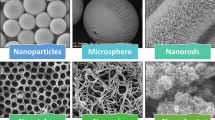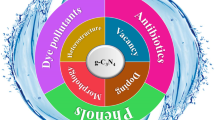Abstract
The development of photocatalysts for degradation of toxic pollutants is an increasingly important research area because of environmental pollution. In this paper, in order to exploit efficient photosensitizers with appropriate electronic states to enhance the transfer of electrons, TiO2–CdS heterostructures were synthesized by a facile, hydrothermal method. The samples were characterized by X-ray diffraction, transmission electron microscopy, X-ray photoelectron spectroscopy, and photoluminescence techniques. The degradation of the cationic dye rhodamine B (RhB) in water and perylene in organic solution by TiO2–CdS hetrostructures were investigated in detail. The results showed that the heterostructure largely enhanced the photosensitized degradation of RhB and perylene. They were supposed to arise mainly from the effective contact between the CdS and TiO2 nanoparticles. Such a heterostructure photocatalyst has much significance in the degradation of toxic and persistence organic pollutants contaminants in the environment.
Graphical Abstract














Similar content being viewed by others
References
Martin DJ, Qiu K, Shevlin SA, Handoko AD, Chen X, Guo Z, Tang J (2014) Highly efficient photocatalytic h 2 evolution from water using visible light and structure-controlled graphitic carbon nitride †. Angew Chem Int Ed 53(35):9240–9245
Katz E, Willner I (2004) Integrated nanoparticle-biomolecule hybrid systems: synthesis, properties, and applications. Angew Chem Int Ed 43(45):6042–6108
Vengosh A, Jackson RB, Warner N, Darrah TH, Kondash A (2014) A critical review of the risks to water resources from unconventional shale gas development and hydraulic fracturing in the United States. Environ Sci Technol 48(15):8334–8348
Rengarajan T, Rajendran P, Nandakumar N, Lokeshkumar B, Rajendran P, Nishigaki I (2015) Exposure to polycyclic aromatic hydrocarbons with special focus on cancer. Asian Pac J Trop Biomed 5(3):182–189. doi:10.1016/S2221-1691(15)30003-4
Liao Y, Zhang H, Zhong Z, Jia L, Bai F, Li J, Zhong P, Chen H, Zhang J (2013) Enhanced visible-photocatalytic activity of anodic TiO2 nanotubes film via decoration with CuInSe2 nanocrystals. Acs Appl Mater Interfaces 5(21):11022–11028
Dong H, Zeng G, Lin T, Fan C, Chang Z, He X, Yan H (2015) An overview on limitations of TiO 2 -based particles for photocatalytic degradation of organic pollutants and the corresponding countermeasures. Water Res 79:128–146
Georgaki I, Vasilaki E, Katsarakis N (2014) A study on the degradation of carbamazepine and ibuprofen by TiO2 & ZnO photocatalysis upon UV/visible-light irradiation. Am J Anal Chem 05(8):518–534
Wilhelm RA, El-Said AS, Krok F, Heller R, Gruber E, Aumayr F, Facsko S (2015) Highly charged ion induced nanostructures at surfaces by strong electronic excitations. Prog Surf Sci 90(3):377–395
Jariwala D, Sangwan VK, Lauhon LJ, Marks TJ, Hersam MC (2014) Emerging device applications for semiconducting two-dimensional transition metal dichalcogenides. Acs Nano 8(2):1102–1120
Augugliaro V, Litter M, Palmisano L, Soria J (2006) The combination of heterogeneous photocatalysis with chemical and physical operations: a tool for improving the photoprocess performance. J Photochem Photobiol C 7(4):127–144
Shkrob IA, Sauer MC Jr (2004) Hole scavenging and photo-stimulated recombination of electron–hole pairs in aqueous TiO2 nanoparticles. J Phys Chem B 108(33):12497–12511
Tian J, Zhao Z, Kumar A, Boughton RI, Liu H (2014) Recent progress in design, synthesis, and applications of one-dimensional TiO2 nanostructured surface heterostructures: a review. Chem Soc Rev 43(20):6920–6937
Ibhadon AO, Fitzpatrick P (2013) Heterogeneous photocatalysis: recent advances and applications. Catalysts 3(1):189–218
Sun H, Wang S (2014) Research advances in the synthesis of nanocarbon-based photocatalysts and their applications for photocatalytic conversion of carbon dioxide to hydrocarbon fuels. Energy Fuels 28(1):22–36
Kowalska E, Yoshiiri K, Wei Z, Zheng S, Kastl E, Remita H, Ohtani B, Rau S (2015) Hybrid photocatalysts composed of titania modified with plasmonic nanoparticles and ruthenium complexes for decomposition of organic compounds. Appl Catal B Environ 178:133–143
Ao Y, Xu J, Fu D, Yuan C (2009) Synthesis of C, N, S-tridoped mesoporous titania with enhanced visible light-induced photocatalytic activity. Microporous Mesoporous Mater 122(1–3):1–6
Reddy KM, Baruwati B, Jayalakshmi M, Rao MM, Manorama SV (2005) S-, N- and C-doped titanium dioxide nanoparticles: synthesis, characterization and redox charge transfer study. J Solid State Chem 178(11):3352–3358
Zhao H, Tian F, Wang R, Chen R (2014) A review on bismuth-related nanomaterials for photocatalysis. Rev Adv Sci Eng 3(1):3–27
Park H, Gutierrez M, Wu X, Kim W, Zhu XY (2013) Optical probe of charge separation at organic/inorganic semiconductor interfaces. J Phys Chem C 117(21):10974–10979
Kalanur SS, Hwang YJ, Joo OS (2013) Construction of efficient CdS–TiO2 heterojunction for enhanced photocurrent, photostability, and photoelectron lifetimes. J Colloid Interface Sci 402:94–99. doi:10.1016/j.jcis.2013.03.049
Zhu W, Liu X, Liu H, Tong D, Yang J, Peng J (2010) Coaxial heterogeneous structure of TiO2 nanotube arrays with CdS as a superthin coating synthesized via modified electrochemical atomic layer deposition. J Am Chem Soc 132(36):12619–12626. doi:10.1021/ja1025112
Mora-Sero I, Gimenez S, Fabregat-Santiago F, Gomez R, Shen Q, Toyoda T, Bisquert J (2009) Recombination in quantum dot sensitized solar cells. Acc Chem Res 42(11):1848–1857. doi:10.1021/ar900134d
Ruhle S, Shalom M, Zaban A (2010) Quantum-dot-sensitized solar cells. ChemPhysChem 11(11):2290–2304. doi:10.1002/cphc.201000069
Eiden-Assmann S, Widoniak J, Maret G (2004) Synthesis and characterization of porous and nonporous monodisperse colloidal Tio2 particles. Chem Mater 16(1):6–11. doi:10.1021/cm0348949
Fan W, Zhang Q, Wang Y (2012) Semiconductor-based nanocomposites for photocatalytic H2 production and CO2 conversion. Phys Chem Chem Phys 15(8):2632–2649
Song G, Xin F, Chen J, Yin X (2014) Photocatalytic reduction of CO2 in cyclohexanol on CdS–TiO2 heterostructured photocatalyst. Appl Catal A 473:90–95. doi:10.1016/j.apcata.2013.12.035
Lavand AB, Malghe YS, Singh SH (2015) Synthesis, characterization, and investigation of visible light photocatalytic activity of C doped TiO2/Cds core-shell nanocomposite. Indian J Mater Sci 2015(2015):1–9
Zhu L, Yin Y, Wang C-F, Chen S (2013) Plant leaf-derived fluorescent carbon dots for sensing, patterning and coding. J Mater Chem C 1(32):4925–4932. doi:10.1039/c3tc30701h
Watanabe T, Takizawa T, Honda K (1977) Photocatalysis through excitation of adsorbates. 1. Highly efficient N-deethylation of rhodamine B adsorbed to cadmium sulfide. J Phys Chem 81(19):1845–1851. doi:10.1021/j100534a012
Moussawi RN, Patra D (2016) Nanoparticle self-assembled grain like curcumin conjugated ZnO: curcumin conjugation enhances removal of perylene, fluoranthene, and chrysene by ZnO. Sci Rep 6:24565. doi:10.1038/srep24565
Acknowledgements
This work was financially supported by the National Natural Science Foundation of China (21505033, 21571093 and 111, project), the Program for Innovative Research Team in Science and Technology in University of Henan Province (18IRTSTHN002), and the PhD Start-up Fund of Henan Normal University, China (qd15112).
Author information
Authors and Affiliations
Corresponding author
Rights and permissions
About this article
Cite this article
Yang, H., Liu, Z., Wang, K. et al. A Facile Synthesis of TiO2–CdS Heterostructures With Enhanced Photocatalytic Activity. Catal Lett 147, 2581–2591 (2017). https://doi.org/10.1007/s10562-017-2151-0
Received:
Accepted:
Published:
Issue Date:
DOI: https://doi.org/10.1007/s10562-017-2151-0




